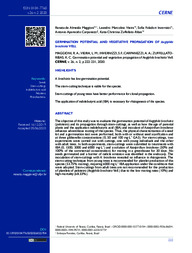Germination potential and vegetative propagation of Aegiphila brachiata Vell.
Germination potential and vegetative propagation of Aegiphila brachiata Vell.
Author(s): MAGGIONI, R. A.; VIEIRA, L. M.; INVERNIZZI, S. F; CARPANEZZI, A. A.; ZUFFELLATO-RIBAS, K. C.
Summary: The objective of this study was to evaluate the germination potential of Aegiphila brachiata (peloteiro) and its propagation through stem-cuttings, as well as how the age of parental plants and the application indolebutyric acid (IBA) and inoculant of Azospirillum brasilense influence adventitious rooting of the species. Thus, the physical characterization of a seed lot and a germination test were performed, both with or without seed scarification and at three gibberellin concentrations (0, 50 and 100 mg.L-1 GA3). For stem-cuttings, two experiments were carried out with cuttings, one with young individuals and the other with adult trees. In both experiments, stem-cuttings were submitted to treatments with IBA (0, 1500, 3000 and 6000 mg.L-1) and a solution of Azospirillum brasilense (50% and 100% of the commercial concentration) for rooting in a greenhouse for 30 days. No seeds germinated and a barrier of radicle emission was identified in the endocarp. The inoculation of stem-cuttings with A. brasilense revealed no influence in rhizogenesis. The stem-cutting technique from young trees is recommended for plantlet production of this species (53.75% rooting), requiring 6000 mg.L-1 IBA application under the conditions that were adopted. Stem-cuttings from adult trees are not recommended for the production of plantlets of peloteiro (Aegiphila brachiata Vell.) due to the low rooting rates (10%) and high mortality (68.33%).
Publication year: 2020
Types of publication: Journal article
Unit: Embrapa Forestry
Observation
Some of Embrapa's publications are published as ePub files. To read them, use or download one of the following free software options to your computer or mobile device. Android: Google Play Books; IOS: iBooks; Windows and Linux: Calibre.
Access other publications
Access the Agricultural Research Database (BDPA) to consult Embrapa's full library collection and records.
Visit Embrapa Bookstore to purchase books and other publications sold by Embrapa.

